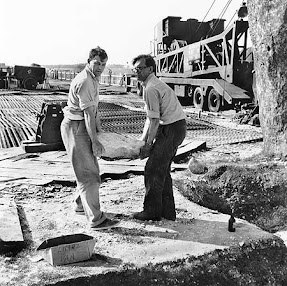As readers of this blog will know, I'm not a great one for speculations. I spend a lot of my time criticising fantasies and speculations, and people who dress up speculations as the truth.
But every now and then, a spot of speculation can be fun, and in reading up a bit on the Great Cursus, it seems to me that nobody has ever suggested that it might have been the place where stones were found, or the place from which stones were collected for the building of Stonehenge. They must have come from somewhere..........
Sounds crazy? Well, maybe, and my money is still on it being a sort of processional feature, along which people walked for some ceremonial or ritual (ie non-economic or "irrational") purpose currently unknown. It's a better hypothesis than the Roman race track or the spacecraft landing strip hypotheses........ and I'm not all that convinced by the ideas that the enclosed strip was either sacred or cursed, or that it was deliberately enigmatic, built by people for whom the act of building was all that mattered. Built for symbolically keeping things in, or keeping them out? Or was it not an enclosure at all, but a line between a landscape devoted to the living, on one side, and a landscape devoted to the dead, on the other. Or maybe a line between a ceremonial landscape and a "normal" landscape where people just got on with their lives? Or maybe it has an "astronomical" origin, aligned as it is towards the horizon sunrise on the equinox?
I don't like the line idea, because there are two slight embankments, more or less parallel to one another. If the Neolithic builders had wanted to demarcate a boundary or a frontier, surely they would have been happy with one embankment, maybe made even higher and more prominent?
And the processional idea is also somewhat strange, because the ends of the 3 km routeway are closed off -- so there is no entrance and no exit. Which way would people have walked? Westwards or eastwards? Probably westwards, because near the western end there is a cluster of barrows and other features -- but the round barrows are considerably younger than the Cursus embankment, and so they could not have been involved in any funerary processions heading towards the sunset. On the other hand, the long barrow called Amesbury 42 is close to the eastern end, and so maybe they walked towards that........ and that one has the advantage of being more or less the right age.
It's intriguing that the Cursus seems to be unrelated to the landscape in that it drops down across the chalklands into Stonehenge Bottom valley and up again on the other side, so topography does not seem to have determined its location.
So is there anything that might point us towards the Cursus as having something to do with stones -- either bluestones or sarsens? Or both? Well, it may or may not be significant that there are abundant records of bluestone "fragments" being found in association with the Cursus -- especially at the western (Fargo Plantation) end. The finds are mostly from field walking collections; there are only two recorded excavations running across the whole width of the Cursus, one in 1917 and the other in 1959. The other excavations have been on the embankments -- mostly concentrating on the search for materials (such as antler picks) that might permit radiocarbon dating.The researcher who seems to have been most intrigued by the Cursus was Jack Stone in 1949 -- according to some sources he cut a trench across the Cursus and was so impressed by the concentrations of bluestone fragments near Fargo Plantation and between the Cursus and the site of Stonehenge that he thought there might have been a "bluestone monument" at the former site that was dismantled, modified and then reconstructed in the monument we see today. If bluestones were at one time scattered across the landscape as an erratic trail or train aligned with the direction of ice movement, and then collected and used as building materials, we might expect to find occasional extraction pits or hollows, and maybe patches of degraded till. No such things are known -- although it has to be said that nobody has ever looked for them.
This is just a suggestion, and I am not at all sure how seriously to take it. But remember -- you saw it here first.............













